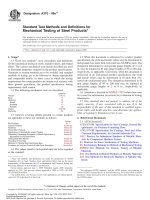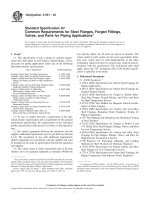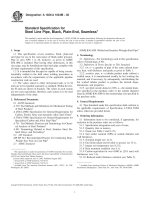Astm a 713 04 (2017)
Bạn đang xem bản rút gọn của tài liệu. Xem và tải ngay bản đầy đủ của tài liệu tại đây (86.09 KB, 3 trang )
This international standard was developed in accordance with internationally recognized principles on standardization established in the Decision on Principles for the
Development of International Standards, Guides and Recommendations issued by the World Trade Organization Technical Barriers to Trade (TBT) Committee.
Designation: A713 − 04 (Reapproved 2017)
Standard Specification for
Steel Wire, High-Carbon Spring, for Heat-Treated
Components1
This standard is issued under the fixed designation A713; the number immediately following the designation indicates the year of
original adoption or, in the case of revision, the year of last revision. A number in parentheses indicates the year of last reapproval. A
superscript epsilon (´) indicates an editorial change since the last revision or reapproval.
2.2 Society of Automotive Engineers Standard:4
J 1086 Numbering Metals and Alloys
2.3 AIAG Standard:5
AIAGB-5 02.00 Primary Metals Identification Tag Application Standard
1. Scope
1.1 This specification covers round carbon spring steel wire
in coils intended for the manufacture of mechanical springs and
wire forms that are heat treated (austenitized, quenched, and
tempered) after fabrication.
1.2 The values stated in inch-pound units are to be regarded
as the standard.
3. Terminology
3.1 Definitions:
3.1.1 heat-treated components—mechanical springs or wire
forms that are austenitized, quenched, and tempered after
fabrication.
2. Referenced Documents
2.1 ASTM Standards:2
A370 Test Methods and Definitions for Mechanical Testing
of Steel Products
A510 Specification for General Requirements for Wire Rods
and Coarse Round Wire, Carbon Steel
A700 Guide for Packaging, Marking, and Loading Methods
for Steel Products for Shipment
A941 Terminology Relating to Steel, Stainless Steel, Related
Alloys, and Ferroalloys
E29 Practice for Using Significant Digits in Test Data to
Determine Conformance with Specifications
E30 Test Methods for Chemical Analysis of Steel, Cast Iron,
Open-Hearth Iron, and Wrought Iron (Withdrawn 1995)3
E112 Test Methods for Determining Average Grain Size
E350 Test Methods for Chemical Analysis of Carbon Steel,
Low-Alloy Steel, Silicon Electrical Steel, Ingot Iron, and
Wrought Iron
E527 Practice for Numbering Metals and Alloys in the
Unified Numbering System (UNS)
3.2 Refer to Terminology A941 for a more detailed description of heat-treating terms.
4. Ordering Information
4.1 It shall be the responsibility of the purchaser to specify
all requirements that are necessary for material under this
specification. Such requirements include, but are not limited to,
the following:
4.1.1 Quantity (weight),
4.1.2 Name of material (Sections 1 and 7),
4.1.3 Diameter (Table 1),
4.1.4 Packaging, marking, and loading (Section 12),
4.1.5 ASTM designation and date of issue,
4.1.6 Special requirements (Sections 8 and 9), and
4.1.7 End use.
NOTE 1—A typical ordering description is as follows: Steel Wire, High
Carbon Spring, for Heat-Treated Components, Grade 1070, to ASTM
A713 dated ________, for Door Closer Springs, 30 000 lb, Size 0.250 in.
in 500-lb Catch Weight Coils.
5. General Requirements for Delivery
1
This specification is under the jurisdiction of ASTM Committee A01 on Steel,
Stainless Steel and Related Alloys and is the direct responsibility of Subcommittee
A01.03 on Steel Rod and Wire.
Current edition approved March 15, 2017. Published March 2017. Originally
approved in 1975. Last previous edition approved in 2010 as A713 – 04 (2010).
DOI: 10.1520/A0713-04R17.
2
For referenced ASTM standards, visit the ASTM website, www.astm.org, or
contact ASTM Customer Service at For Annual Book of ASTM
Standards volume information, refer to the standard’s Document Summary page on
the ASTM website.
3
The last approved version of this historical standard is referenced on
www.astm.org.
5.1 Material furnished under this specification shall conform to the applicable requirements of the latest edition of
Specification A510 unless otherwise specified herein.
4
Available from American Society of Mechanical Engineers (ASME), ASME
International Headquarters, Three Park Ave., New York, NY 10016-5990, http://
www.asme.org.
5
Available from Automotive Industry Action Group (AIAG), 26200 Lahser Rd.,
Suite 200, Southfield, MI 48033, .
*A Summary of Changes section appears at the end of this standard
Copyright © ASTM International, 100 Barr Harbor Drive, PO Box C700, West Conshohocken, PA 19428-2959. United States
1
A713 − 04 (2017)
TABLE 1 Permissible Variations in Wire Diameter
7.3 An analysis of each cast or heat shall be made by the
manufacturer to determine the percentage of elements specified
in Table 2. The chemical composition thus determined shall be
reported to the purchaser or his representative upon request.
NOTE 1—For purposes of determining conformance with this
specification, all specified limits are considered absolute as defined in
Practice E29.
Diameter, in. (mm)
0.035 to 0.075 (0.89 to 1.90), incl
Over 0.075 to 0.375 (1.90 to 9.52), incl
Over 0.375 to 0.625 (9.52 to 15.88), incl
Permissible
Variations,
Plus and
Minus, in.
(mm)
Permissible
Out-of-Round,
in. (mm)
0.001 (0.03)
0.002 (0.05)
0.003 (0.08)
0.001 (0.03)
0.002 (0.05)
0.003 (0.08)
7.4 A product analysis may be made by the purchaser. The
chemical composition thus determined, as to elements required
or restricted, shall conform to permissible variations for
product analysis as specified in Table 10 in Specification A510.
For referee purposes, Test Methods E30 or Test Methods E350
shall be used.
8. Metallurgical Structure
8.1 Austenitic grain size, when specified, shall be determined in accordance with the requirements of Test Methods
E112 or some other mutually agreeable method.
6. Materials and Manufacture
6.1 The steel shall be made by the open-hearth, basicoxygen, or electric-furnace process.
9. Mechanical Properties
9.1 Tensile strength is not normally a requirement. Minimum or maximum values for tensile strength may be agreed
upon between the purchaser and manufacturer and are dependent on the chemical composition, thermal treatment, and
diameter of wire specified.
6.2 The wire, prior to fabrication, shall be thermally treated
or thermally treated and drawn.
6.3 The condition or wire (metallurgical and mechanical
properties) to be used is at the discretion of the purchaser and
is generally dependent on the severity of the component part to
be formed.
9.2 Wrap Test:
9.2.1 Requirements—Wire shall wind without fracture on a
cylindrical mandrel of a diameter specified in Table 3. The
wrap test is not applicable to wires over 0.312 in. (8 mm).
Since the conventional methods will not accommodate wire
sizes over 0.312 in., an alternative test procedure may be
agreed upon between the purchaser and manufacturer.
9.2.2 Number of Tests—At least one test specimen shall be
taken for each ten coils or fraction thereof in a lot.
9.2.3 Location of Test—The test specimen shall be taken
from either end of the coil.
9.2.4 Test Method—The wrap test shall be made in accordance with Supplement IV of Test Methods and Definitions
A370.
7. Chemical Composition
7.1 The steel shall conform to the requirements for chemical
composition prescribed in Table 2 for the grade ordered.
7.2 A chemical composition other than those shown in Table
2 may be supplied when agreed upon by the manufacturer and
purchaser.
TABLE 2 Chemical Composition
NOTE 1— The following ranges of silicon are commonly specified for
high-carbon steels: 0.10 to 0.20 %; 0.15 to 0.30 %; 0.20 to 0.40 %; or 0.30
to 0.60 %.
10.1 The diameter of the wire shall not vary from the
specified size by more than the tolerance shown in Table 1.
Composition, %
UNS
DesignationA
Grade
Carbon
Manganese
Phosphorus,
max
Sulfur,
max
G
G
G
G
G
G
G
G
G
G
G
G
G
G
G
G
G
G
1055
1059
1060
1064
1065
1069
1070
1074
1075
1078
1080
1084
1086
1090
1095
1561
1566
1572
0.50–0.60
0.55–0.65
0.55–0.65
0.60–0.70
0.60–0.70
0.65–0.75
0.65–0.75
0.70–0.80
0.70–0.80
0.72–0.85
0.75–0.88
0.80–0.93
0.80–0.93
0.85–0.98
0.90–1.03
0.55–0.65
0.60–0.71
0.65–0.76
0.60–0.90
0.50–0.80
0.60–0.90
0.50–0.80
0.60–0.90
0.40–0.70
0.60–0.90
0.50–0.80
0.40–0.70
0.30–0.60
0.60–0.90
0.60–0.90
0.30–0.50
0.60–0.90
0.30–0.50
0.75–1.05
0.85–1.15
1.00–1.30
0.040
0.040
0.040
0.040
0.040
0.040
0.040
0.040
0.040
0.040
0.040
0.040
0.040
0.040
0.040
0.040
0.040
0.040
0.050
0.050
0.050
0.050
0.050
0.050
0.050
0.050
0.050
0.050
0.050
0.050
0.050
0.050
0.050
0.050
0.050
0.050
10550
10590
10600
10640
10650
10690
10700
10740
10750
10780
10800
10840
10860
10900
10950
15610
15660
15720
10. Dimensions and Tolerances
11. Workmanship
11.1 The surface of the wire as received shall be substantially free of rust and such other surface imperfections of a
nature or degree, for the grade ordered, that will be detrimental
to the fabrication of the parts.
TABLE 3 Wrap Test Requirements
Mandrel Sizes
Wire Diameter, in. (mm)
Up to 0.162 (4)
Over 0.162 to 0.312 (4 to 8), incl
Grades to
1090
Grades 1090
and Over
1×A
2×
2×
3×
A
The symbol × represents the diameter of the wire tested. For 1× mandrel, wire
may be wrapped around itself.
A
Designation established in accordance with Practice E527 and SAE J 1086.
2
A713 − 04 (2017)
13.3 The material must be adequately protected and correctly identified in order that the manufacturer may make a
proper investigation.
11.2 Wire drawn as a final operation shall not be kinked or
improperly cast. To test for a cast, a single convolution, or ring,
of wire shall be cut from the bundle and placed on a flat
surface. The wire shall lie substantially flat and not spring up.
The wire shall not show a wavy condition.
14. Certification
14.1 Upon request of the purchaser in the contract or
purchase order, a manufacturer’s certification that the material
was manufactured and tested in accordance with this specification together with a report of the test results shall be
furnished at the time of shipment.
11.3 Each coil of wire shall be one continuous length.
11.4 Wire may be processed with welds made prior to wire
drawing. Weld areas need not meet the mechanical requirements of the specification. If unmarked welds are unacceptable
to the purchaser, special arrangements should be made with the
manufacturer at the time of purchase.
14.2 The certification shall include the specification
number, year date of issue, and revision letter, if any.
12. Inspection
15. Packaging, Marking, and Loading
12.1 The manufacturer shall afford the inspector representing the purchaser all reasonable facilities to satisfy him that the
material being furnished is in accordance with this specification. All tests (except product analysis) and inspections shall be
made at the place of manufacturer prior to shipment, and shall
be so conducted as not to interfere unnecessarily with the
operation of the works.
15.1 Packaging of the coils of wire shall be by agreement
between the manufacturer and the purchaser. This agreement
shall include coil dimensions and weights.
15.2 When specified, the packaging, marking, and loading
shall be in accordance with Practices A700.
15.3 Marking shall be by tag securely attached to each coil
of wire and shall show the identity of the manufacturer, size of
the wire, grade, ASTM specification number, and cast or heat
number.
13. Rejection and Rehearing
13.1 Unless otherwise specified, any rejection based on tests
made in accordance with this specification shall be reported to
the manufacturer within a reasonable length of time.
15.4 Bar Coding—In addition to the previously-stated identification requirements, bar coding is acceptable as a supplementary identification method. Bar coding should be consistent
with AIAG Standard 02.00, Primary Metals Identification Tag
Application. The bar code may be applied to a substantially
affixed tag.
13.2 Failure of any of the test specimens to comply with the
requirements of this specification shall constitute grounds for
rejection of the lot represented by the specimen. The lot may be
resubmitted for inspection by testing every coil for the characteristic in which the specimen failed and sorting out the
nonconforming coils.
16. Keywords
16.1 components; heat treated; high-carbon; spring; wire
ASTM International takes no position respecting the validity of any patent rights asserted in connection with any item mentioned
in this standard. Users of this standard are expressly advised that determination of the validity of any such patent rights, and the risk
of infringement of such rights, are entirely their own responsibility.
This standard is subject to revision at any time by the responsible technical committee and must be reviewed every five years and
if not revised, either reapproved or withdrawn. Your comments are invited either for revision of this standard or for additional standards
and should be addressed to ASTM International Headquarters. Your comments will receive careful consideration at a meeting of the
responsible technical committee, which you may attend. If you feel that your comments have not received a fair hearing you should
make your views known to the ASTM Committee on Standards, at the address shown below.
This standard is copyrighted by ASTM International, 100 Barr Harbor Drive, PO Box C700, West Conshohocken, PA 19428-2959,
United States. Individual reprints (single or multiple copies) of this standard may be obtained by contacting ASTM at the above
address or at 610-832-9585 (phone), 610-832-9555 (fax), or (e-mail); or through the ASTM website
(www.astm.org). Permission rights to photocopy the standard may also be secured from the Copyright Clearance Center, 222
Rosewood Drive, Danvers, MA 01923, Tel: (978) 646-2600; />
3









